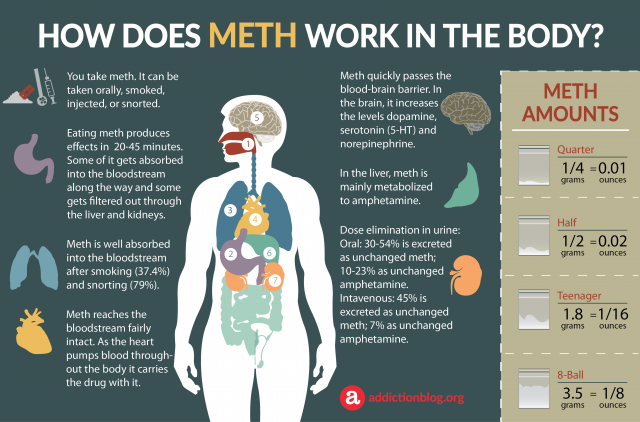How Meth Really Works
In this meth infographic, we’ll describe how meth works on the body. We graphically describe the metabolism involved when you take meth and how it gets to the brain. Find out more about how meth really works here.
At the end, we invite you to post your questions and feedback on the subject of meth effects on the brain and body. We value your experiences and make sure to provide you with a personal and prompt response.

Meth is Highly Effective, but Highly Addictive
Q: Why do people use meth?
A: Most people reach for meth (methamphetamine) because it changes the way they feel.
Some people take meth to dampen painful emotion. Others use meth because it’s really effective at getting you high for up to 10-12 hours. In fact, the meth high can last for a very long time. But at the root, using meth can really be a defense mechanism against pain. In some cases, regular use has even been clinically considered “self-medication”.
Meth works in the brain to trigger a chemical euphoria. But this high comes at a cost. The psychoactive effects of methamphetamine are dual in nature. On the one side, methamphetamine produces euphoria – a sense of extreme well-being. But on the other side, this drug can damage both your brain and your body.
Methamphetamine in the Brain
Methamphetamine works by increasing the amount of the natural feel good chemical, “dopamine”. This hormone is involved in body movement, motivation, pleasure, and reward stimulated by natural behaviors. Meth’s ability to release high levels of dopamine rapidly in reward areas of the brain produces the “rush” (euphoria), or “flash” that many people experience. But the high isn’t the only effect of meth.
The effects felt after long-term meth use include:
- aggressive or violent behavior
- changes in brain structure and function
- deficits in thinking and motor skills
- increased distractibility
- memory loss
- mood disturbances
- severe dental problems
- weight loss
Trying to live with meth in your system constantly is like tasking the body to work ten times faster than normal. The end result? The stimulation becomes too much; your brain and body get burned out.
How Does Meth Work In The Body?
1. YOU TAKE METH: It can be administered orally, smoked, injected, or snorted.
2. STOMACH: Eating meth produces effects in about 20-45 minutes because it has to travel through the digestive system. Some of it gets absorbed into the bloodstream along the way and some gets filtered out through the liver and kidneys.
3. LUNGS: Methamphetamine is well absorbed into the bloodstream after smoking or intranasal administration, with bioavailabilities of 79% after snorting and 37.4% after smoking.
4. HEART: Following administration, methamphetamine reaches the bloodstream fairl intact. As the heart pumps blood throughout the body it carries the drug with it.
5. BRAIN: Meth quickly passes the blood-brain barrier. In the brain, it increases the levels dopamine, serotonin (5-HT) and norepinephrine. It speeds up the work of the whole body and produces locomotor effects, psychosis, and perception disturbances.
6. LIVER: Methamphetamine is broken down in the liver. It is mainly metabolized to amphetamine.
7. KIDNEYS: Between 30-54% of an oral dose is excreted in urine as unchanged meth and 10-23% as unchanged amphetamine. Following an intravenous dose, 45% is excreted as unchanged meth and 7% amphetamine. The half-life of meth can be anywhere in the range of 5 – 30 hours.
METH AMOUNTS
- Quarter = 0.25 gr or 0.01 oz
- Half = 0.50 gr or 0.02 oz
- Teenager = 1.8 gr or 0.0625 oz
- 8-Ball = 3.5 gr or 0.125 oz
Get Personalized Meth Addiction Treatment Text Support
Receive 24/7 text support right away and at your convenience. There is no obligation to enter treatment and you can opt out at any time.
Want to get help, but not ready to talk? Instead, sign up for text support to receive:
- Resources about addiction and recovery
- Information about our treatment process
Meth In The Body Questions
We strive to educate and inform all our readers about the damaging consequences of meth use. One of the ways we provide our help is by answering the questions you ask. Now, we welcome you to post your questions and comments in the designated section below. We’ll do our best to provide a personal and prompt response to all legitimate inquiries.








Related Posts